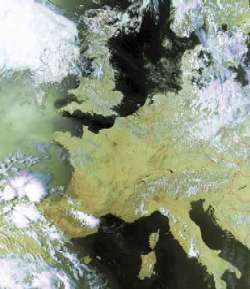|
|
 |
|
|
|
 |
| |
|
|
 |
Weather
Basics |
High Pressure Systems,
Low Pressure Systems
|
|
|
|
|
 |
Air always flows from areas of high pressure to areas of low pressure, aiming to reach the equilibrium. But, because of the deviating force caused by the rotation of the Earth (namely Coriolis effect) it does not flow in a straight line. Instead of it, the winds form a spiral: inwards and upwards in low pressure systems, downwards and outwards in high pressure systems.
|
 |
 |
 |
|
1. Eye of the Storm, Hurricane Elena
© Dreamtime, NASA's Multimedia Partner
|
|
Please read also about tropical cyclones, hurricanes and expectations for the future in the ACCENT school magazine: special edition on hurricanes
|
 |
 |
|
2. In cyclones the winds move counter-clockwise around a low pressure in the northern hemisphere. In southern hemisphere these wind direction is reversed.
figure: volvooceanadventure ©
|
|
 |
Low pressure systems – Cyclones
Regions of rising air called lows, low pressure systems, depressions or cyclones. Cloudy conditions, windy weather, periods of rain, and in winter, snow, unsettled, changable weather often occur in these regions.
A low pressure system develops where relatively warm and moist air ascends from the Earth's surface. These are systems of closed isobars (lines of constant pressure) surrounding a region of relatively low pressure.
Air near the centre of low pressure systems is unstable. As warm, humid air, which spirals upward cools clouds, that may thick enough to give rain or snow, will begin to form.
In low pressure systems air spirals inwards at the Earth’s surface. If the pressure is very low, the wind may reach storm or hurricane force. That is why the term cyclone has often been more loosely applied to storm and disturbance attending such pressure systems, particularly violent tropical hurricanes and typhoons.
|
|
Tropical and midlatitude cyclones
There are two types of cyclones, which are different in their structure, but also in their developments.
Tropical cyclones
|
 |
 |
|
Tropical cyclones develop over the ocean in warm and moist tropical air masses, between the 20th to 25th degree of latitude, either north or south of the equator. They are much smaller than midlatitude cyclones, have diameters of around 100-1500 km. Because of the air pressure in their center is much lower, and their diameter is much smaller, in tropical cyclones the decrease in air pressure for unit distance (pressure gradient) usually much higher than in midlatitude cyclones. That is why they can cause very strong winds: in hurricanes and typhoons these are over 33 m/s (120 km/h), with a record of 104 m/s (375 km/h) – in hurricane Allan, 1980.
Tropical cyclones gain their energy from the latent heat of the evaporation of the water from the ocean, therefore gradually dissipate when they move across land and lose their energy source.
Midlatitude cyclones
|
|
 |
 |
 |
|
3. left: Tropical cyclone named Graham taken out in the pacific
source: www.gowilmington.com
4. right: NOAA satellite imagery shows strong Tropical Cyclone 03A moving northeast across the Arabian Sea toward landfall in northwest India.
source: weather.ou.edu
click for larger images!
left: 62 kB
right: 275 kB
|
|
 |
 |
|
5. left: The way how weather fronts develop around a low pressure system.
6. right: The development of midlatitude cyclones north of the Equator (top) and south of the Equator (bottom).
source: volvooceanadventure ©
Please click on the pictures for enlarge!
|
|
 |
 |
 |
|
Midlatitude cyclones are powered by large temperature differences in the atmosphere: they develop when air masses with different temperatures meet. The air does not mix well and the warmer air mass moves up and over the other causing a front (see also chapter 3) to form.
Midlatitude cyclones are much larger than tropical cyclones, have diameters of 1000-4000 km, and have also lower wind speed than tropical cyclones: their top speeds are around 30 m/s (110 km/h).
|
|
High pressure systems - anticyclones
Regions of sinking air are called highs, high pressure regions or anticyclones. They are usually accompanied by constant, good or fair weather.
Compared to low pressure systems, highs tend to cover a greater area, move more slowly and have a longer life.
Anticyclones are produced by a large mass of descending air. As the air sinks and high atmospheric pressure occurs, the descending air warms up and the relative humidity is reduced, so water droplets in the air soon evaporate.
|
 |
 |
 |
|
7. In anticyclones the winds move clockwise around a high pressure in the northern hemisphere. In southern hemisphere these wind direction is reversed (see also Figure 2.).
source: www.geologia.com
Please click ont he picture for enlarge!
|
|
The warm, sinking air makes the atmosphere stable, so warm air at the surface of the Earth cannot rise far before it stops. This prevents tall clouds from forming. For this reason, anticyclones usually lead to warm, dry weather and cloudless skies particularly in the summer (cold in winter), which usually lasts for several days or even weeks.
Anticyclones are much larger than cyclones, and may block the path of depressions, forcing it to travel elsewhere: either slowing down the bad weather, or forcing it round the outside of the high pressure system. An anticyclone that persists for a long period is known as a „blocking high” and may lead to long hot spells of weather and even droughts during the summer months and extremely cold in winter.
|
 |
 |
 |
|
8. Anticyclon over France
Cloudless, fair weather
source: Passion Meteo
photo made by a NOAA satellite
|
|
About this page:
author: Vera Schlanger - Hungarian Meteorological Service
scientific reviewing: Dr. Ildikó Dobi Wantuch / Dr. Elena Kalmár - Hungarian Meteorological Service, Budapest
last updated: 2004-02-23 |
Further reading:
www.bom.gov.au
www.scalloway.org.uk
www.geocities.com
www.wxresearch.org
www.volvooceanadventure.org
www.ace.mmu.ac.uk
www.docm.mmu.ac.uk
www.ecn.ac.uk |
|
 |
|









